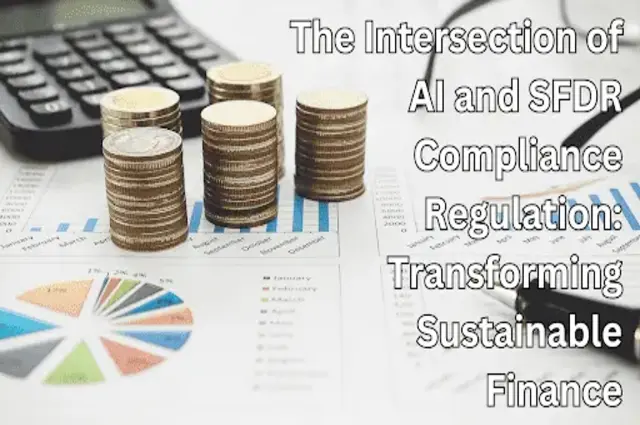Issues concerning the people in terms of the climate change and the degradation of the environment serves as a call for people to take on the action, and the financial sector will play a major role in achieving and maintaining the sustainability of transition, as well as, the acceleration to a greener and healthier community. One of the epitome of this is the European Union’s Sustainable Finance Disclosure Regulation (SFDR) which is founded to ensure the transparency and the accountability in sustainable finance when it comes to matters like climate change and such.
This organization present an acceptable obstacle for different financial firms that observes and oversees several and different portfolios and assets. But, because of the advancement of technology in the 21st century, artificial intelligence and the machine learning, both can offer hope to ease the burdens in compliance. Innovations in technology does not only provide convenience, but also ensures a smooth streamline adherence to regulations in order to advance the industry. Thus, this can create various opportunities and chances for growth and development by enriching the innovative sustainable investment strategies.
1. Understanding SFDR and Its Significance
As what was stated, the organization [SFDR] encourages sustainability by ensuring that the financial market players will reveal the risks to sustainability and the several effects their investments may have impacted on ESG or the environment, social, and governance factors. This directive and organization mandates and observes the financial instruments sorted based on the sustainable aims, accompanied by a detailed justification of how the sustainable risk factors into the investment are affected.
2. The Difficulty of Meeting SFDR Standards
Complying with SFDR is challenging due to the need for extensive data collection, analysis, and reporting. It’s particularly taxing for institutions managing complex portfolios. The difficulty lies in gathering consistent ESG data, assessing sustainability risks and impacts, and accurately reporting primary adverse impacts (PAIs), all of which are compounded by the dynamic nature of ESG factors and regulatory requirements.
The procedure is slow due to several obstacles. Accurately calculating and disclosing PAIs, assessing the sustainability risks and effects of investments, and gathering consistent and trustworthy ESG data from several sources are challenging tasks.
The challenge of SFDR compliance is further complicated by the dynamic nature of ESG elements and the changing legal environment, which necessitate constant monitoring and modification.
3. AI’s Role in Meeting SFDR Guidelines
Artificial intelligence and machine learning will offer many tools to tackle the complexities of the SFDR compliance regulation, fostering the integration of sustainable finance principles into investment processes. Financial institutions can streamline compliance tasks through these advanced technologies, enhance data analysis, and discover fresh avenues for sustainable investment strategies.
a. Streamlining Data Collection and Analysis
One of the biggest obstacles to fulfilling SFDR regulations is gathering and reviewing voluminous ESG data from many sources. Techniques for artificial intelligence and machine learning manage data from sources including social media, external data providers, business filings, and news sites with ease. They help firms comprehend the sustainability risks and repercussions of their investments by analyzing disorganized data, finding pertinent ESG elements, and revealing linkages and changes.
b. Assessing Sustainability Risks
AI and ML systems can recognize and evaluate sustainability-related investment risks. They take into account multiple factors including industry trends, legal changes, overall economic conditions, and environmental, social, and governance (ESG) performance. Through analysis of large datasets, these models provide information on possible risks and opportunities, allowing companies to make educated investment decisions that support sustainability goals. Furthermore, risk assessment solutions driven by AI aim to regularly update risk profiles to align with market changes and advancements in sustainable strategies.
c. Automating PAI Calculations
Accurate reporting of principal adverse impacts of PAIs plays a vital role in meeting SFDR requirements. AI and ML algorithms streamline the calculation of PAIs by integrating various data inputs and considerations. This streamlining guarantees accurate and uniform reporting, all while mitigating the possibility of human mistakes and lightening administrative loads.
d. Conducting Scenario Analysis and Portfolio Optimization
Tools for artificial intelligence and machine learning make it possible to analyze and improve investment portfolios in light of sustainability standards. These technologies evaluate the possible risks and benefits of different investment options by simulating a variety of scenarios, such as the effects of climate change and regulatory changes, using algorithms. Financial institutions can use these results to adjust portfolios in order to reduce risk and capitalize on sustainable opportunities while meeting sustainability goals and SFDR requirements.
4. Challenges and Considerations
While SFDR compliance and sustainable finance programs stand to gain from AI and ML, their integration and adoption present some obstacles. For financial institutions to successfully incorporate new technologies and fully utilize their potential, a number of issues need to be resolved.
a. Data Quality and Accessibility
The success of AI and ML models hinges greatly on the caliber and accessibility of data. Making precise analyses and informed decisions relies on obtaining dependable, thorough, and diverse ESG data from multiple channels. To tackle this challenge, financial institutions might need to invest in enhancing their data infrastructure and establishing alliances with credible data providers.
b. Model Governance and Transparency
As AI and ML models get more complicated and less transparent, it’s crucial to focus on maintaining sufficient monitoring and openness. To ensure the moral and responsible use of these technologies while upholding open and accountable decision-making procedures, robust governance frameworks must be established.
c. Regulatory Compliance and Supervision
Although AI and ML technologies can aid with achieving SFDR requirements, it’s vital to emphasize compliance with current regulations and standards. Maintaining data privacy, ethical AI practices, and sustainable finance principles while navigating the ever changing legal landscape requires strong collaboration with industry associations and regulatory bodies.
d. Talent Acquisition and Skill Development
Using AI and ML to support sustainable finance and guarantee adherence to SFDR standards calls for specialized knowledge and experience. To build these skills, financial institutions may need to hire qualified workers and conduct internal training. As an alternative, they might work with experts and technology companies to identify answers.
Conclusion
We can do a lot for our environment but we need more resources to ensure that our plans will not go to waste. This is the reason why the finance industry plays a significant and important role to ensure sustainability, and promoting the positive impacts on the ESG by incorporating the AI with SFDR compliance regulations. Through the AI and ML technologies, SFDR will be able to enhance their compliance processes, and explore fresh venues for their sustainable investment strategies.
AI has been utilized by many sectors and we can do a lot with the intelligence that they can offer, we can do as much for our environment. This will be our way of giving back to mother earth while utilizing the power of our minds, and technology.
FAQs
- What does SFDR mean, and what effect does it have on green finance?
- The Sustainable Finance Disclosure Regulation (SFDR), is founded to ensure the transparency and the accountability in sustainable finance when it comes to matters like climate change and matters concerning ESG.
- How does artificial intelligence aid in adhering to SFDR?
- Artificial intelligence presents financial institutions with ways to streamline regulatory compliance, and environmentally conscious investment strategies. AI can make it easier to collect data, and analyze it. With just one click, it manages the data collected.
- What difficulties are encountered when incorporating AI into SFDR adherence?
- There are always difficulties in anything, and when you incorporate AI into SFDR, it will present problems in accuracy which is a very important thing considering that they are a large organization. However, with an organization as big as theirs, they must surmount these challenges and successfuly use AI in meeting the SFDR compliance.



 Delving into the Unseen: How Engine Oil Dictates Car Efficiency
Delving into the Unseen: How Engine Oil Dictates Car Efficiency  Essential Protection for Tactical Missions: Gear, Strategy, and Safety Essentials
Essential Protection for Tactical Missions: Gear, Strategy, and Safety Essentials  The Mythical World of “American Gods”: Why Neil Gaiman’s Tale Endures
The Mythical World of “American Gods”: Why Neil Gaiman’s Tale Endures  Developing Analytical Skills Through English Literature
Developing Analytical Skills Through English Literature  What to Consider When Choosing an Online Real Estate Course
What to Consider When Choosing an Online Real Estate Course  Mapping the Employee Journey: A Strategic View at the Employee Experience Framework
Mapping the Employee Journey: A Strategic View at the Employee Experience Framework